 Please Join us as we
Please Join us as we
welcome veteran
South Asian advertising guru Prem Dutt to the Siliconeer family.
Email Prem
Call Prem: (510) 797-8315
|
EDITORIAL:
The Art of Rajasthan
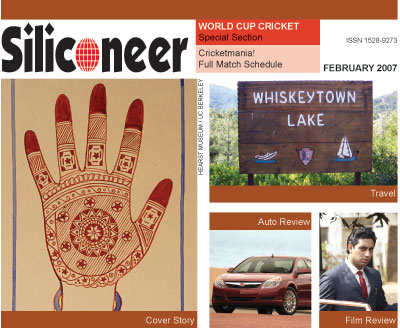 Rajasthan is sheer magic. Anybody who has visited that storied land of the Rajas has unforgettable memories of desert landscapes, camel caravans and its unforgettable fortress cities. Rajasthan is sheer magic. Anybody who has visited that storied land of the Rajas has unforgettable memories of desert landscapes, camel caravans and its unforgettable fortress cities.
Whenever Indians visit the state, they are struck by the arresting beauty of the artistry that is part of the everyday life of Rajasthan, be it the miniature paintings of its upper-crust denizens, or the colorful designs of the men’s turbans and the cloth rings that women use to rest their water vessels on their heads.
Trouble is, it’s about 10,000 miles away from California, so even if the thought of Rajasthan makes you wistful, you can’t visit it at a moment’s whim.
The next best thing would be if Rajasthan came to you — and that’s pretty much what the Phoebe A. Hearst Museum of Anthropology in Berkeley, Calif., has managed to accomplish in its exquisite exhibit that opens this month. This exhibit, which runs for almost a year and is open and free to the public at this University of California museum, gives visitors a vivid sense of the artistic temperament that permeates that desert state.
From a 30-foot painted scroll depicting the epic of Pabuji, a semi-divine folk hero, to examples of domestic crafts, wedding textiles, festival material, puppets and theatrical costumes, ritual masks, musical instruments, paintings for traveling storytellers, temple sculptures and paintings, and paintings made for tourists, the exhibit is a wonderful introduction to the state for the uninitiated and a delight for the Rajasthan aficionado.
Many of the pieces are uncommon in American museum collections because of their large size.
Hearst Museum research anthropologist Ira Jacknis provides an introduction to this marvelous exhibit in our cover story this month. This is an absolutely must-see exhibit for South Asians. Put the word out, and don’t come alone, bring an American friend with you!
Sandeep Pandey, our India editorial consultant, is nothing if not contrarian. Trained as a mechanical engineer with a Ph.D. from the University of California at Berkeley, today he runs an ashram in a small town in Uttar Pradesh. The Magsaysay award-winning activist did teach briefly at IIT Kanpur, but left in disgust after the IIT authorities were unhappy with his efforts to help construction workers organize and bid for IIT contracts.
In this issue, he reflects on the gap between India’s strides in knowledge and the widespread hunger and poverty of its masses.
In India the socio-economic disparities are ghastly, and not only is it unclear that these disparities are diminishing notwithstanding the nation’s blistering economic growth rates, the elite seems to be too absorbed in narcissistic navel-gazing to care much one way or the other.
While we cannot say we agree with everything he says, we have to say he does make a few sobering points. His appeal for a more humane, egalitarian and communitarian society may seem utopian, but few would argue when he writes: “Until wisdom is wedded to education, unless science, technology and IT and its users follow a value system which is the basis for a just human order, the fruits of modern development will not be shared equitably by all.”
Filmmaker Suma Josson has chronicled the dark side of Indian economic reforms in her heartbreaking documentary films I Want My Father Back and Before the Last Tree Falls. While the Indian — and the Western media as well — wax eloquent over how India is set to tower in the global economy in the future, Josson’s films depict with scary clarity the terrible human toll in India’s rural hinterland caused by policies driven by free market ayatollahs who rule the roost in Washington and multilateral organizations like the World Bank, the International Monetary Fund and the World Trade Organization.
The current buzz word is BRIC (for Brazil, Russia, India, China) coined by investment banker Goldman Sachs which has projected that India will overtake the United States by 2050 to become the world’s second largest economy after China. No one is talking about India’s farmers, who are on a suicide spree unprecedented in its history.
Fully two thirds of the Indian population depends on agriculture, so this is the real India. Josson shows how their traditional methods of farming, developed over millennia, are being systematically destroyed by policies that serve global corporate interests.
Subsidies have been withdrawn, farmers no longer grow their own seeds but have to buy it in the market where pesticide merchants tout it, and traditional multi-crop farming has been replaced by single cash crops.
The result is capital-intensive, soil-destroying farming with pesticides and fertilizers. Farmers are up to their neck in debt, but sell their produce at abysmal price as it competes in the global “free” market where prices are artificially low, thanks to massive farm subsidies farmers in the affluent West.
This month’s issue carries an article on Suma Josson’s work.
Do drop us a line with ideas and comments about how we can make Siliconeer better serve you.
|TOP|
COVER STORY:
Land of the Rajas: Berkeley Exhibit
A year-long exhibit opens this month at the Hearst Museum at the University of California at Berkeley showcasing Rajasthan’s colorful and distinctive art styles.
Ira Jacknis presents an introduction.
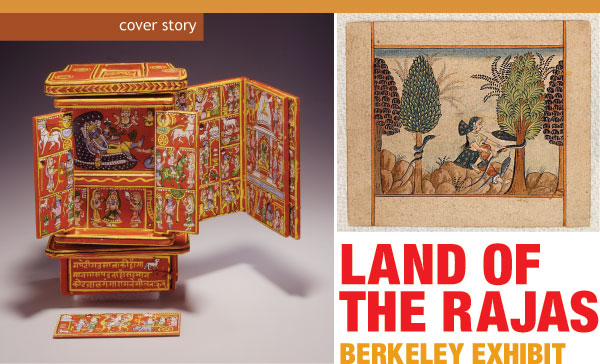
(Above): The small drawer of this storyteller’s shrine is painted with cows, contains the following message: “This container is for the cow shelter, to buy grass for cows … suggested donation 201 rupees.” (Right): Rajasthani painting of a woman with snakes, in a forested and rocky place. [All photos courtesy HEARST MUSEUM / UC BERKELEY]
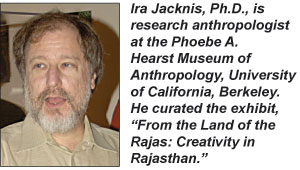 Rajasthan, a state in northwestern India, is famed for its colorful and distinctive art styles. For centuries, its princely rulers have encouraged a wide range of arts. The arts of Rajasthan (literally “land of kings”) are distinguished by a complex interplay between court and village traditions, especially evident in those used in ritual performances. Rajasthan, a state in northwestern India, is famed for its colorful and distinctive art styles. For centuries, its princely rulers have encouraged a wide range of arts. The arts of Rajasthan (literally “land of kings”) are distinguished by a complex interplay between court and village traditions, especially evident in those used in ritual performances.
These traditions are explored in a current exhibition at the Phoebe A. Hearst Museum of Anthropology at the University of California at Berkeley, “From the Land of the Rajas: Creativity in Rajasthan,” on view now through Dec. 21. As the curator, I was inspired to put on the show about eight years ago. For a class that she was teaching, Prof. Joanna Williams, the university’s expert in South and Southeast Asian art history, had requested a large, rolled-up painting that I had not seen before. I was overwhelmed with this giant and detailed painting of Krishna and Radha, and vowed to one day find a way to share it with the public. This exhibition now offers us the opportunity to present this and other wonderful objects, many of which have never been displayed before.
“From the Land of the Rajas” explores the social and cultural context of visual artistry in the desert state. The exhibition focuses on festival and religious arts, especially those concerned with pictorial narrative. Among the roughly 150 objects in the exhibit are domestic crafts, marriage and festival arts, puppets and theatrical costumes, ritual masks, musical instruments, paintings for traveling storytellers, temple sculpture and painting, and tourist painting. Two featured works are an over-thirty-foot-long painted scroll depicting the epic of Pabuji, a semi-divine folk hero, and a large temple painting devoted to the worship of Krishna.
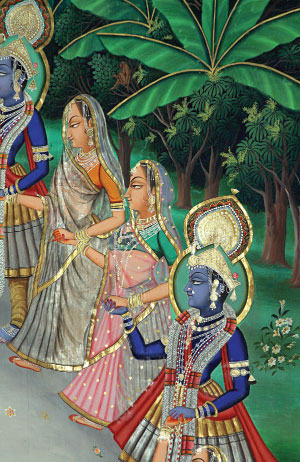 (Right): Detail of a painted temple wall-hanging called a pichhavai depicts Krishna dancing with milkmaids (gopis) (detail). (Right): Detail of a painted temple wall-hanging called a pichhavai depicts Krishna dancing with milkmaids (gopis) (detail).
Almost all the pieces on display come from the rich Hearst collection from Rajasthan, about 230 items. Most were acquired in 1969–70 by Dr. Renaldo J. Maduro (1942–88), then a U.C. Berkeley anthropology graduate student, as part of his dissertation research on creativity among Rajasthani painters. In anticipation of the exhibit, in the summer of 2005 the museum commissioned a small collection of related objects; and a few pieces are on loan from private collectors.
As an anthropology museum, we aim to explore the social and cultural contexts of artistry in Rajasthan. Who makes these objects, and who do they make them for? What are they intended for, and where they are used? In fact, few of the arts on display are “folk art,” in the sense that they are made by untrained individuals. Instead, almost are the products of professional artisans, trained in family traditions. To illustrate this perspective, we have arranged the objects according to a combination of form and function, reflecting how different kinds of objects are used and seen in different Rajasthani settings, such as the field, home, fair, theater, tribal ceremony, temple, and market.
At the same time, we attend to more aesthetic issues of form and meaning. Are designs representational or abstract? What associations do colors have? What features are selected to represent gods? Are narrative scenes laid out in a series or all at once? “From the Land of the Rajas” contains a rich assortment of traditional Rajasthani styles of painting and decoration, full of gods, kings, and heroes.
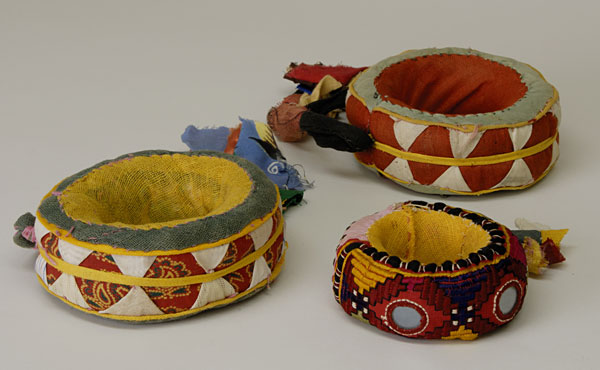
(Above): Colorful Rajasthani carrying rings for balancing water pots on top of one’s head.
To set the scene, we start with the most famous of Rajasthani arts: the tradition of miniature court painting. Moving then to the homes and field of rural Rajasthan, we present several objects illustrating the important role played by camels in Rajasthan, especially among the worshippers of the hero Pabuji. One case of domestic crafts presents a representative sampling of the state’s renowned craft media, primarily pottery and metalwork. Rajasthan is famous for its brilliantly-colored and richly decorated clothing. After some examples of the distinctive types of decoration, primarily kinds of tie-dying and block-printing, comes a representative sample of women’s and men’s clothing, household textiles, and a set of brilliantly embroidered shoes.
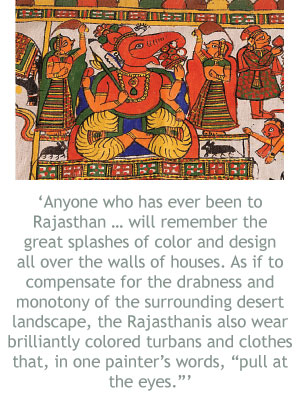 (Right): Detail from a scroll painting (par or phad) that tells the story of epic hero Pabuji. This particular scroll is very large, running 36’ in length. (Right): Detail from a scroll painting (par or phad) that tells the story of epic hero Pabuji. This particular scroll is very large, running 36’ in length.
The central section in the exhibit’s first half deals with marriage — one of the most important aspects of Rajasthani life, and, consequently, a dominant theme of its art. Through the wedding ceremony, ordinary people explicitly model themselves on gods and kings. Among the decorative objects used in weddings are door decorations, wall hangings, henna hand paintings, a painted container for vermillion powder, and, of course, a full set of married women’s jewelry. A nearby case on festival arts features a pair of ceramic figures for the Gangaur festival (a spring fertility festival), a rakhi arm ornament for Raksha-Bandan, and a baby’s bonnet for the spring Holi festival.
A section on folk drama contains decorative objects used in common plays. Famous Rajasthani kings are the main subjects of both the puppet plays (illustrated by a lively set of marionettes) and the khyal drama (seen in a set of colorful costume turbans). These court-derived traditions are contrasted with the bold masks for the Gavari dance drama, which is a Bhil tribal version of a Hindu fertility myth.
The methods of visual storytelling are vividly explored in two portable religious shrines used by itinerant bards: a storyteller’s box of painted folding screens, narrating the exploits of Krishna and Rama; and the 32-foot scroll illustrating the story of the folk hero Pabuji.
Since the early 16th century, rural Rajputs and Rebari shepherds and camel herders have worshipped the hero Pabuji. He seems to have been a real person, a minor ruler of the Rathor Rajputs, living in Marwar (around Jodhpur) during the early 14th century. Now regarded as a god, he is prayed to during the sickness of humans and livestock and for other misfortunes. Although there are temples dedicated to him, for at least the past two centuries his worship has centered around the ritual performance of a lengthy epic poem recounting his exploits. By tradition, these stories have been recited by bhopas (folk priests) who travel from village to village with a painted scroll illustrating his story. Although the complete story takes about 36 hours to recite, they usually spend one night recounting a portion of his story before moving on. Because of the decline in the viability of herding in Rajasthan, as well as the greater exposure to modern media such as movies and television, this ancient tradition is currently endangered.
 (Right): Painting for a domestic shrine: Krishna as Sri Nathji. This piece was made by artist Pannalal Motilal and his sons.
Our scroll, about twice the size of a usual par, was painted around 1969 by Durgesh Kumar and Rajesh Kumar Joshi of Shahpura. It is in a bold and dramatic style characteristic of Rajasthani popular art. Unlike a movie or comic book—or the nearby story-teller’s shrine—the story on the scroll is not illustrated in sequence from one side to the other. Instead, it is more like a map, representing distinct places mentioned in the story. As the bard recites the epic he dances from one part to another, pointing with his bow to the relevant section. Nearby is a case of musical instruments that accompany these performances: the ravanhatha spike fiddle and dholak hand drum. (Right): Painting for a domestic shrine: Krishna as Sri Nathji. This piece was made by artist Pannalal Motilal and his sons.
Our scroll, about twice the size of a usual par, was painted around 1969 by Durgesh Kumar and Rajesh Kumar Joshi of Shahpura. It is in a bold and dramatic style characteristic of Rajasthani popular art. Unlike a movie or comic book—or the nearby story-teller’s shrine—the story on the scroll is not illustrated in sequence from one side to the other. Instead, it is more like a map, representing distinct places mentioned in the story. As the bard recites the epic he dances from one part to another, pointing with his bow to the relevant section. Nearby is a case of musical instruments that accompany these performances: the ravanhatha spike fiddle and dholak hand drum.
The core of the exhibit is devoted to Hindu worship, with sections on shrine and temple decoration, amulets, and votive ceramic plaques. These illustrate a range of divine imagery: Krishna, Ganesha, Amba Mata, Hanuman, and Nandi. Because of his prominence in Hindu devotion, we have a separate section on Krishna, seen as a mischievous child, a youth dancing with milkmaids, a flute-player, and in the venerated form of Shri Nathji.
Perhaps the single most impressive object in the show is the large and detailed painting—measuring about 9 feet high and 8 feet wide—that first inspired me. It depicts the Rasa Lila, the divine dance of Krishna and the milkmaids (gopis). Associated with the cult of Krishna in Nathadwara, a pilgrimage site in southern Rajasthan, these pichhavai paintings are placed behind the statue of Krishna in the temple. Although much larger in scale, these pichhavais follow the tradition of the more finely-detailed miniature paintings. Our example, one of two in the collection, was painted around 1969 by the noted artist Kanhaiyalal (ca. 1900–98). This image is complemented by two smaller but fine paintings of Krishna as Sri Nathji, made for purchase by pilgrims. To balance the focus on Hinduism in the rest of the exhibit, we also include a marble figurine used in Jain devotion.
The final section reveals how these courtly and ritual arts have been reflected in versions made as fine art for the commercial market. Since the abolition of princely titles and privileges in 1971, tourists have replaced kings as the prime patrons of Rajasthani artists. While modest in size, the exquisite miniatures, from the courtly tradition, continue to illustrate popular subjects of gods and kings.
The objects are contextualized with a rich array of media: many vivid photographs of Rajasthani life, recordings of Krishna songs, and a video documentary about the narration of the Pabuji scroll and its current fate in modern India. Following its normal practice, the Hearst Museum will also prepare an on-line version of the exhibit (http://hearstmuseum.berkeley.edu/exhibitions/rajasthan).
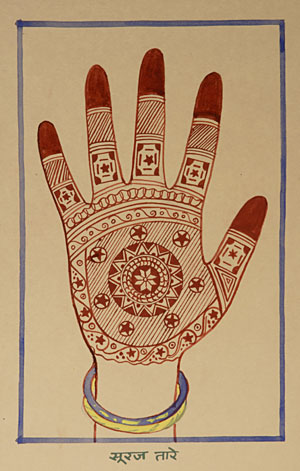 (Right): Design for henna hand-painting from the Udaipur District of Rajasthan (Right): Design for henna hand-painting from the Udaipur District of Rajasthan
With this exhibition, the Hearst Museum is proud to share with the general public some extremely impressive, rare, and beautiful paintings, setting them against the colorful and diverse scene of Rajasthani life. Because of their large size and ritual use, the featured paintings are rare in American collections, and so offer an exceptional glimpse into the ritual arts of an Indian region famed for its tradition of court painting. We expect the subject to appeal to the large local Indian American community in the Bay Area. Over the coming year, the Hearst Museum well be presenting a full suite of public programs, including lectures, demonstrations, films, and performances.
“From the Land of the Rajas” is a tribute to the spectacular artistry of traditional Rajasthan. It well illustrates the observation of collector Renaldo Maduro: “Anyone who has ever been to Rajasthan … will remember the great splashes of color and design all over the walls of houses. As if to compensate for the drabness and monotony of the surrounding desert landscape, the Rajasthanis also wear brilliantly colored turbans and clothes that, in one painter’s words, “pull at the eyes.”
More information is available at:
http://hearstmuseum.berkeley.edu
Email: pahma@berkeley.edu;
Phone: (510) 642-3682
Cover photo: Jodhpuri-style shoes (Hearst Museum, UC Berkeley, photo).
|TOP|
COMMENT:
Wisdom & Knowledge: The Limits of Science
IUntil wisdom is wedded to education, unless science users adopt as their goal a just human order, the fruits of modern development will not be shared equitably by all, writes Sandeep Pandey.

One would assume that education, science and technology and information technology, all seemingly very progressive things, will have a role in combating hunger and violence. However, experience shows that these tools have been exploited by the elite and powerful to create worse conditions of hunger and violence. Advances in development based on the above-mentioned tools have only served to increase the gap between the rich and the poor. The problems of hunger and violence have certainly not been mitigated by modern development propelled by the achievements in science and technology. They continue to stare at us, demanding more urgent attention than ever before.
 The process of education is considered to be desirable. There is an underlying assumption that education will produce a better society and will help us in solving the problems of the society. Education is meant to produce enlightened citizens. The process of education is considered to be desirable. There is an underlying assumption that education will produce a better society and will help us in solving the problems of the society. Education is meant to produce enlightened citizens.
However, the competition-inducing education system makes us less sensitive towards our fellow human beings. The educated class is seen to become self-serving, concerning itself less with social problems. The education system has materially benefited only a miniscule minority of the population, considering that only nine percent of the Indian population enters the college level of education. Most of the students either drop out or are ejected out of the system. Even the people who complete their education are not able to fulfill their aspirations in the jobs that they end up with. Hence a condition of material and mental poverty prevails even after receiving education.
The major scientific intervention in agriculture, the green revolution, did seem to present the illusion of solving the problem of India’s perennial shortage of food. However, we continue to have starvation deaths and farmer suicide incidents, probably in numbers larger than before. In Uttar Pradesh alone, more than 40 hunger deaths have taken place over the last three years and farmers have committed suicide at a rate exceeding one per day over the last five years. Even the epicenter of green revolution, Punjab, is witnessing farmer suicides. Obviously, something went amiss. The scientific intervention created more problems than it solved. The agricultural fields and groundwater are now poisoned with pesticides and hazardous chemicals. The political system could not deliver the benefits of enhanced production to the poor. Massive siphoning off of food grains which come as part of the Public Distribution System or earlier what was called the Food for Work program made the situation worse. More education has not been able to tackle the rickety racket of irregularities and corruption. If anything, matters have deteriorated.
The educated class seems to have accepted the system of commissions and cuts as a way of life and is quite happy to go along with it rather than resisting it. In fact, the training imparted in the education system prepares one mentally to be subservient. This class certainly lacks the courage to change things.
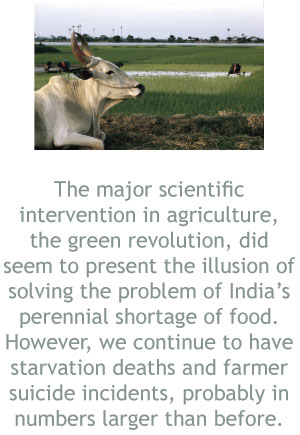 In a broader, global context, it seems clear that because the majority of peoples are not satisfied, uncertainty rules and peace can not be ensured. The power of science and technology has been used to develop the most dangerous weapons. With primitive weapons we could kill people one at a time. Now there were weapons of mass destruction with the amazing prowess of inflicting damage on a horrifyingly larger scale. Hiroshima and Nagasaki were the exhibition and demonstration of that strength. Destruction was justified in the name of science and technology, which goes on to show that wisdom has become completely divorced from the idea of education. In fact, we take pride in glorifying the destructive capacity of science and technology. There should be little surprise that violence has increased manifold as the fruits of modern development became available to human society. In a broader, global context, it seems clear that because the majority of peoples are not satisfied, uncertainty rules and peace can not be ensured. The power of science and technology has been used to develop the most dangerous weapons. With primitive weapons we could kill people one at a time. Now there were weapons of mass destruction with the amazing prowess of inflicting damage on a horrifyingly larger scale. Hiroshima and Nagasaki were the exhibition and demonstration of that strength. Destruction was justified in the name of science and technology, which goes on to show that wisdom has become completely divorced from the idea of education. In fact, we take pride in glorifying the destructive capacity of science and technology. There should be little surprise that violence has increased manifold as the fruits of modern development became available to human society.
Now Information Technology is creating a digital divide so that the more privileged have now more avenues of exploiting opportunities. The poor are more at the mercy of the market as they are becoming more knowledge dis-empowered.
There are rare examples where tools of modern development have helped the poor. The “Lokvani” innovation by the district magistrate of Sitapur, U.P., in 2004 brought some transparency in the administration and made the officials accountable to the people. For a brief period it appeared as if IT offered great potential in realizing the dream of people-friendly governance. However, the system was found to be dependent on the drive of the district magistrate. It did not do as well in most other districts.
Until wisdom is wedded to education, unless science, technology and IT and its users follow a value system which is the basis for a just human order, the fruits of modern development will not be shared equitably by all. We have to free human beings from the clutches of markets and governments. Only a self-imposed value system and a desire to create a society which is free of all artificial divisions created by human beings can bring happiness and prosperity. The value of competition, held so highly by the market and governments, will have to be replaced by the value of cooperation. The objectives of education, science and technology and IT will have to be changed. All kinds of destructive activity, justified in the name of knowledge, against human beings, their physical and mental health and environment, will have to be stopped. Sharing will have to be developed as a value and practice. Claims of ownership over natural resources will have to be given up. We have to learn to accept that material resources are meant to take care of everybody’s needs and not for self-aggrandizement. We have to be mentally conditioned to believe the truth that human needs are limited and can be fulfilled by finite resources. The model of more consumption equated to more growth will have to be abandoned.
We would have to believe in a concept of security based on mutually satisfying human relationships. This is the only condition which guarantees permanent peace. The fact that arms add to more insecurity should be as clear as transparent water. An atmosphere of trust in society is the only state which will rule out violence.
The solutions to the problems of hunger and violence, therefore, lie in the domain of wisdom rather than the tools of modern development.
|TOP|
NEWS DIARY: January 2007 Roundup
 Ardh Kumbh Mela: 20 Million Take Holy Dip | Tata Buys Anglo-Dutch Steelmaker Corus | Yunus Lauds Gandhi | Attacks on Shi’ites | India to Overtake U.S. | Protest in Nepal | Court Cancels Book Fair Ardh Kumbh Mela: 20 Million Take Holy Dip | Tata Buys Anglo-Dutch Steelmaker Corus | Yunus Lauds Gandhi | Attacks on Shi’ites | India to Overtake U.S. | Protest in Nepal | Court Cancels Book Fair
Ardh Kumbh Mela: 20 Million Take Holy Dip
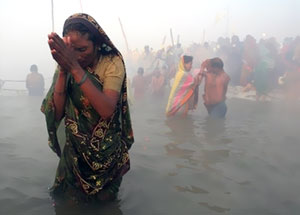 Pilgrims take holy dip at Sangam, the confluence of rivers Ganges, Yamuna and the mythical Saraswati on Vasant Panchami Day, in Allahabad. Pilgrims take holy dip at Sangam, the confluence of rivers Ganges, Yamuna and the mythical Saraswati on Vasant Panchami Day, in Allahabad.
At least 20 million people bathed in the river Ganga in Allahabad, Uttar Pradesh, on the main day of the Ardh Kumbh mela, festival organizers said.
Thousands of Hindu holy men began the plunge at dawn. Crowds bathed until late into the night.
The mela is considered to be the largest gathering of humanity on the planet. The festival began Jan. 3 January and concludes Feb. 16 February. Organizers expect about 60 million people to attend over the six weeks.
Pilgrims believe that bathing at the confluence of three of Hinduism’s holiest rivers washes away their sins. The mass bathing takes place at Sangam, where the Ganga, Yamuna and mythical Saraswati rivers meet.
The new moon night, or Mauni Amavasya, was celebrated Jan. 19. It is the most auspicious day in the six-week-long festival.
Chief organizer R.N. Tripathi said more than 20 million people had taken a holy dip.
The Mauni Amavasya is a day when sun, moon, Venus and Mercury are in the zodiac of Capricorn, a rare but perfect alignment of planets, devotees believe.
All roads leading to the site teemed with pilgrims and more kept arriving.
No traffic was allowed on the roads leading up to the river and thousands of policemen and paramilitary troops were deployed to ensure the orderly movement of people.
Under the alert eyes of security officials, hundreds of vendors sold marigold flowers and sweets, sacred thread and cans to take away the Ganga water.
|Back to NEWS Diary| |TOP|
Tata Buys Anglo-Dutch Steelmaker Corus
 A Corus blast furnace in Port Talbot, Wales. A Corus blast furnace in Port Talbot, Wales.
Indian industrial house Tata has won the battle to take over the Anglo-Dutch steelmaker Corus. Tata Steel’s bid for the steelmaker — which was created from the merger of British Steel and Hoogovens — beat its Brazilian rival CSN’s bid.
Britain’s Takeover Panel said Tata had won after offering 608p per share, valuing Corus at $11.3 billion.
Corus employs 47,300 people worldwide, including 24,000 in the U.K. at plants at Port Talbot, Scunthorpe and Rotherham.
Mumbai-based Tata said its takeover would not lead to job losses in the first phase.
The takeover will create the world’s fifth-largest steel group.
The two-way battle for the firm began in October when Tata tabled a £4.1 billion bid for the group and, in December, the Corus board recommended a revised £4.7 billion offer from Tata.
But, just hours later the board confirmed it had approved a £4.9 billion, offer from Rio de Janeiro-based CSN.
Tata eventually outbid its Brazilian rivals.
Last year Corus was the ninth largest steel producer in the world with 18.2 million metric tons of output. It banked pre-tax profits of £580 million on turnover of £10.14 billion.
Last year Tata Steel, part of the Indian conglomerate Tata Group, was ranked 56th in the list of steelmakers around the world with output of 5.3 million metric tons.
The Tata Group — which owns Tetley tea and Daewoo cars — has operations in more than 50 countries.
|Back to NEWS Diary| |TOP|
Yunus Lauds Gandhi
 Mohammad Yunus Mohammad Yunus
In a keynote speech at a two-day conference observing the Mahatma Gandhi’s satyagraha movement, Bangladesh’s Nobel laureate economist Mohammad Yunus urged the world community to emulate Mahatma Gandhi’s philosophy of tolerance, non-violence, compassion for all humanity and peaceful co-existence for achieving peace and prosperity and an improved life through banishing poverty into museum.
All India Congress Committee president Sonia Gandhi presided over the inaugural ceremony of the conference.
“Within the framework that encompasses Gandhiji’s philosophy of tolerance, non-violence, compassion for all humanity and peaceful co-existence, we can work together to create a world where we can achieve peace not through war, but dialogue and cooperation,” Yunus told the audience.
Later, he said that corporate houses should take up social business initiatives that aim at serving the poor through a non-loss, non-dividend business.
This model should not be misunderstood as philanthropy, he said.
While mooting the idea of a `social stock market’ to list companies that are engaged in businesses in the social sector, he said such a market would allow people to pick and invest in firms involved in the social development field.
Yunus said India could replicate the micro-finance model of Bangladesh. “It can work for India, as it involved people who are the same everywhere. If you are serious it would happen.’’
According to him, what is critical is a legal framework and regulatory body that will ensure smooth running of the sector, as micro-finance in India is still at a nascent stage. Pointing out that there are 16 million beneficiaries of micro-finance in Bangladesh, which is one-tenth the size of India in terms of population, he said India, therefore, should have at least 160 million beneficiaries.
While focusing on the need to spread the reach of micro-finance and social business in every walk of life, the Nobel laureate said it should form part of the curricula of business schools with the option of specialization in the discipline.
|Back to NEWS Diary| |TOP|
Attacks on Shi’ites
 Shi’ite mourners protest against violence in Karachi. Shi’ite mourners protest against violence in Karachi.
Rocket and mortar fire killed at least two people in Pakistan Jan. 30 as a Shi’ite religious procession dispersed in a town known for sectarian violence, police and hospital officials said.
Thirteen policemen and a civilian were wounded in the attack in Hangu, in North West Frontier Province, where a year ago 40 people were killed by a suicide bomber during an Ashura procession, the climax of the Islamic holy month of Muharram for followers of the Shi’ite sect.
Senior administrator Fakkahar-e-Alam said the Shi’ites came under fire as this year’s Ashura procession dispersed.
The two people killed were Afghan refugees, said senior police official Mohammad Sharif.
The roof of a building collapsed in a village near Lahore injuring 48 people who had been watching a procession in the street below, police said. Among the injured were 28 women, a police official said.
There has been a spate of sectarian attacks in the days leading up to this year’s Ashura.
On Jan. 29, a suicide bomber killed himself and two others in another northwestern town of Dera Ismail Khan, the third suicide attack in days.
Also on the same day, two rockets struck close to a Shi’ite religious center in the northwestern town of Bannu wounding 13 people.
A suicide bomber killed himself Jan. 26 and a guard outside the Marriott hotel in Islamabad, and the following day, a suicide bomber killed 15 people, including a city police in the northwestern city of Peshawar, shortly before Shi’ite mourners were to begin a procession.
Thousands of people have been killed in sectarian attacks by Sunni and Shi’ite militants in Pakistan since the 1980s. Shi’ites make up about 15 percent of the mostly Sunni Muslim country’s population
|Back to NEWS Diary| |TOP|
India to Overtake U.S.
 A high-rise building in Mumbai lit up during construction. Goldman Sachs says India will overtake the United States by 2050. A high-rise building in Mumbai lit up during construction. Goldman Sachs says India will overtake the United States by 2050.
With the current growth rate of over 8 percent, which is sustainable, India will challenge the global economic order in the next 15 years and by 2050 it will be second largest economy after China overtaking the United States, according to a Goldman Sachs’ Economic Research Report on Global Economics released recently.
The report by the world’s leading investment banker says India can sustain the growth rate of about 8.4 percent till 2020 and on an average basis should be 6.9 percent until 2050.
“The underlying causes for the increase in efficiency of private firms have been acceleration in international trade, financial sector growth, and investments in and adoption of information and communication technology,” it says.
“India’s current growth rate of around 8 percent can be increased 10 percent, if the efficiency level in term of productivity to capital employed is being increased and also the saving rate increased marginally to sustain the investment.
“India needs to boost its investment rate by another 16 percent of the GDP to achieve and sustain a growth rate of 10 percent,” the report says.
In addition, it says that the labor movement from agriculture to industry will fuel the growth by one percent. “The movement of surplus labor away from low-productivity agriculture to high productivity industry and services contributes about 1 percentage point to annual GDP growth. India is well positioned to reap the benefits of favorable demographics, including an urbanisation bonus over the long term.”
However, it warns that India will need continued progress in reducing the fiscal deficit and in enhancing education at all levels. “We also see threats to the growth process from protectionism, supply-side constraints to doing business, and environmental degradation,” it says.
|Back to NEWS Diary| |TOP|
Protest in Nepal
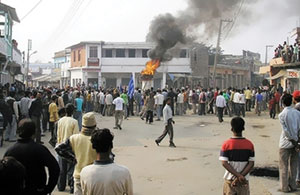 Demonstrators from Nepal’s Mahadhesi ethnic group burn tires during protests at Jaleswor, 232 miles south of Kathmandu. Demonstrators from Nepal’s Mahadhesi ethnic group burn tires during protests at Jaleswor, 232 miles south of Kathmandu.
The Nepal government and former rebel Maoists have agreed to demands by protesters in the southeast of the country for greater political representation in an effort to halt ethnic unrest in which nine people have died, officials said.
Home Minister Krishna Prasad Sitaula told reporters new electoral constituencies would be added for key elections due to be held before June, and the demand for increased federalization of the Terai region would be addressed.
“In principle we have agreed to establish a federal state of government but the new constitution to be formed by the constituent assembly will decide on the structure,” Sitaula told reporters after three hours of talks between leaders of the seven parties in government and the Maoists.
“The new constituencies will be formed based upon population and geography. This is the demand of the Nepali people,” the home minister said.
“We think we have addressed the key issues of the Mahadhesi people and we are hopeful that the protests will cease,” Maoist spokesman Krishna Bahadur Mahara told AFP.
The agreement comes after nearly two weeks of rioting in Nepal’s impoverished southern Terai region by members of the Mahadhesi community, who have long complained of being discriminated against and underrepresented in government.
The Terai area, known as Nepal’s “bread basket,” is a low-lying region bordering India and is dominated by the Mahadhesi community.
Mahadhesi leaders say their group accounts for at least a third of impoverished Nepal’s 27 million people yet is under-represented in Kathmandu’s corridors of power — even after the recent sidelining of the king.
|Back to NEWS Diary| |TOP|
Court Cancels Book Fair
The Kolkata High Court has refused to allow the annual book fair in Kolkata to go ahead at a central park on environmental grounds.
The Calcutta Book Fair is one of Asia’s largest fairs of its kind. Since it began in 1976, the event has been held at the Maidan, a huge green open space in the heart of the city, drawing crowds of book lovers daily.
The court ruling follows months of campaigning by environmentalists who said it would cause irreparable damage.
In a report submitted to the court, the state pollution control board said the city’s pollution level goes up substantially during the 12-day event.
The court also declared permissions acquired by the organizers — the Publishers and Booksellers Guild — from various different government agencies to be invalid.
Recently, in an interim order, the court had said that the organizers had lied blatantly to get clearances.
.
|Back to NEWS Diary| |TOP|
|